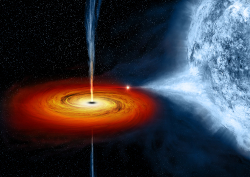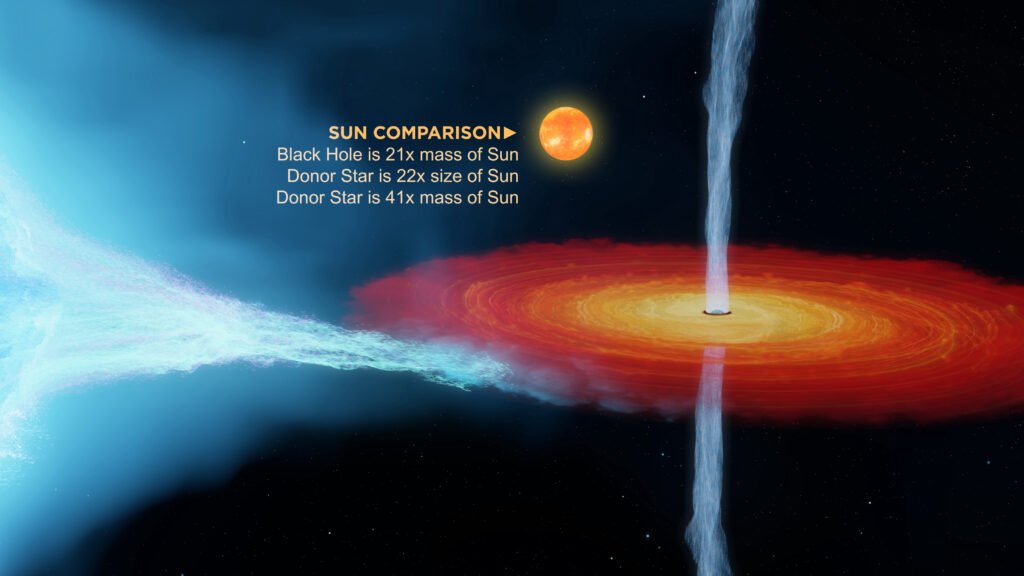Page 1 of 1
HEAPOW: Even Holier Than Thou (2021 Mar 15)
Posted: Tue Mar 16, 2021 4:46 pm
by bystander
 HEAPOW: Even Holier Than Thou (2021 Mar 15)
HEAPOW: Even Holier Than Thou (2021 Mar 15)
Measuring the mass of a black hole, an object that emits no radiation and occupies no space, is a tricky proposition. It requires scientists to go to extraordinary lengths (
depths?) to determine black holes masses. The best measurements of black hole masses are obtained by studying the incredibly tiny gravitational waves they produce when two (or more?) black holes merge together - an almost unbelievably difficult task that was
first accomplished only 5 years ago by the
Laser Interferometer Gravitational-Wave Observatory (LIGO). The LIGO observations came as a bit of a surprise to astrophysicists, since the derived
black hole masses were 5 to 10 times higher than black hole masses estimated through other techniques. The first object ever claimed to be a black hole is an X-ray binary system called
Cygnus X-1, located as a bright X-ray source by the
Uhuru satellite in the 1970's. Cyg X-1's mysteriously bright X-rays, we know now, are produced as the black hole
accretes extremely hot matter from a massive blue companion star. The image above shows an illustration of the Cyg X-1 binary; the black hole is hidden at the center of the disk of hot matter stolen from the companion, and a radio-emitting particle beam shoots into space at the center of the disk, fortunate stuff which escapes the ravenous maw of the black hole. Now, a
new detailed study of high resolution radio images of Cyg X-1 shows that the binary is more distant than previous estimates suggested. The radio images also provided extremely precise measurement of the position of the radio jet from Cyg X-1 over a complete 5.8-day orbit, allowing astronomers to measure the motion of the black hole as it swings around the companion star. The new measurements show that the black hole in Cyg X-1 is 21 times the
mass of the Sun, about 50% larger than previous estimates. Interestingly, this larger mass is more comparable to the masses of the black holes in the mergers observed by the gravitational wave observatories. The higher mass of the black hole suggests that it formed from the collapse of an extremely massive star which was about 50 to 75 times more massive than the Sun.
S&T: First-Detected Black Hole is More Massive Than We Thought
ICRAR: Cygnus X-1 Is More Massive Than We Thought
Posted: Tue Mar 16, 2021 5:36 pm
by bystander
First Black Hole Ever Detected Is More Massive Than We Thought
International Center for Radio Astronomy Research | 2021 Feb 19
First-Detected Black Hole is More Massive Than We Thought
Sky & Telescope | 2021 Feb 22
New observations show that Cygnus X-1, the first black hole to be discovered, is more massive than originally thought — a finding that could challenge ideas about the evolution of massive stars.
Cygnus X-1 is part of a binary system, first discovered in 1964 by its powerful X-rays. Closer inspection showed a supergiant star orbiting an unseen companion every 5.6 days. The black hole is siphoning material away from the star, releasing X-rays and radio jets in the process.
About a decade ago, scientists were able to make the first precise calculations of the system’s distance and mass using the Very Long Baseline Array (
VLBA), a network of radio telescopes spread across the U.S. ... The 2011 observations were taken over the course of a year and suggested that
Cygnus X-1 is about 6,000 light-years away and 15 times the mass of the Sun.
For the current study, Miller-Jones and colleagues used the VLBA to observe the system over six days to watch how the radio emission changes over the course of a single orbit. ... The new results show that Cygnus X-1 is more than 7,000 light-years away and thus more massive than originally thought. The new calculations show the black hole has the mass of 21 Suns; the giant star companion is around 40 solar masses. The results put the radio measurements in agreement with visible-light measurements of parallax from the European Space Agency’s Gaia satellite. ...
Cygnus X-1 Contains a 21-Solar Mass Black Hole —
Implications for Massive Star Winds ~ James C.A. Miller-Jones
et al
Re-estimating the Spin Parameter of the Black Hole in Cygnus X-1 ~ Xueshan Zhao
et al
Wind Mass-loss Rates of Stripped Stars Inferred from Cygnus X-1 ~ Coenraad J. Neijssel
et al
Re: HEAPOW: Even Holier Than Thou (2021 Mar 15)
Posted: Tue Mar 16, 2021 6:28 pm
by neufer
https://www.etymonline.com/search?q=hole wrote:
hole (n.) Old English hol (adj.) "hollow, concave;" as a noun, "hollow place; cave; orifice; perforation," from Proto-Germanic *hulan (source also of Old Saxon, Old Frisian, Old High German hol, Middle Dutch hool, Old Norse holr, German hohl "hollow," Gothic us-hulon "to hollow out"), from PIE root *kel- (1) "to cover, conceal, save." As an adjective, it has been displaced by hollow, which in Old English was only a noun, meaning "excavated habitation of certain wild animals."
---------------------------------------------
whole (adj.) Old English hal "entire, whole; unhurt, uninjured, safe; healthy, sound; genuine, straightforward," from Proto-Germanic *haila- "undamaged" (source also of Old Saxon hel, Old Norse heill, Old Frisian hal, Middle Dutch hiel, Dutch heel, Old High German, German heil "salvation, welfare"), from PIE *kailo- "whole, uninjured, of good omen" (source also of Old Church Slavonic celu "whole, complete;" see health). The spelling with wh- developed early 15c.
---------------------------------------------
holy (adj.) Old English halig "holy, consecrated, sacred; godly; ecclesiastical," from Proto-Germanic *hailaga- (source also of Old Norse heilagr, Danish hellig, Old Frisian helich "holy," Old Saxon helag, Middle Dutch helich, Old High German heilag, German heilig, Gothic hailags "holy"),
Primary (pre-Christian) meaning is not possible to determine, but probably it was "that must be preserved whole or intact, that cannot be transgressed or violated," and connected with Old English hal (see health) and Old High German heil "health, happiness, good luck" (source of the German salutation Heil). Holy water was in Old English.
Holy has been used as an intensifying word from 1837; in expletives since 1880s (such as holy smoke, 1883, holy mackerel, 1876, holy cow, 1914, holy moly etc.), most of them euphemisms for holy Christ or holy Moses.
 HEAPOW: Even Holier Than Thou (2021 Mar 15)
HEAPOW: Even Holier Than Thou (2021 Mar 15)
